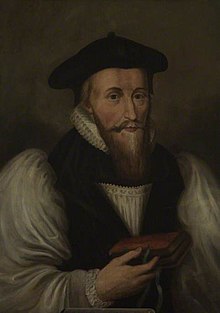James Montague (bishop)
|
The Right Reverend and Right Honourable James Montague |
|
|---|---|
| Bishop of Winchester | |
 |
|
| Diocese | Diocese of Winchester |
| In office | 1616 (translation)–1618 (death) |
| Predecessor | Thomas Bilson |
| Successor | Lancelot Andrewes |
| Other posts | Master of Sidney Sussex (1596–1608) Dean of the Chapel Royal (1603–1618) Dean of Lichfield (1603–1604) Dean of Worcester (1604–1608) Bishop of Bath and Wells (1608–1616) privy counsellor (October 1617–1618) |
| Personal details | |
| Born | 1568 Boughton, Northamptonshire, England |
| Died | 20 July 1618 (aged 49–50) Greenwich, Kent, England |
| Buried | Greenwich (bowels) 20 August 1618, Bath Abbey (body) |
| Nationality | English |
| Denomination | Anglican |
| Parents | Sir Edward Montague of Boughton & Elizabeth (née Harington of Exton), Lady Montague |
| Alma mater | Christ's College, Cambridge |
| Ordination history of James Montague | |
|---|---|
|
Episcopal consecration
|
|
| Principal consecrator | Richard Bancroft (Canterbury) |
| Co-consecrators | Thomas Ravis (London); Henry Cotton (Salisbury); William Barlow (Rochester); Lancelot Andrewes (Chichester); Henry Parry (Gloucester) |
| Date of consecration | 1 April 1608 |
| Place of consecration | Lambeth Palace chapel |
| Source(s): | |
James Montague (c. 1568 – 20 July 1618) was an English bishop.
He was the son of Sir Edward Montagu of Boughton, and grandson of Edward Montagu.
He was a graduate of Christ's College, Cambridge, and became in 1596 the first Master of Sidney Sussex College, Cambridge, for which he laid the foundation stone. He was connected to Frances Sidney, founder of the college, his great-aunt: his maternal grandmother was her sister Lucy Sidney. From that time he was a patron of Thomas Gataker. In 1603 he became Dean of the Chapel Royal. Montague was both a courtier and a Calvinist, and closer to the king than George Abbot, Archbishop of Canterbury; he is considered to have influenced James I against the Arminians. With the other courtiers Sir Robert Darcy and John Harington, 1st Baron Harington of Exton, Montague introduced to court circles, and especially those around Henry Frederick, Prince of Wales, the Puritan Arthur Hildersham, and the radical religious figures Henry Jacob and John Burges.
He edited the collected works of James I; it has been said that his introductions "push the art of panegyric close to deification". He had worked with James on An Apologie for the Oath of Allegiance in 1607, at Royston and Newmarket, reading to James the four volumes of the works of Cardinal Bellarmine.
...
Wikipedia
